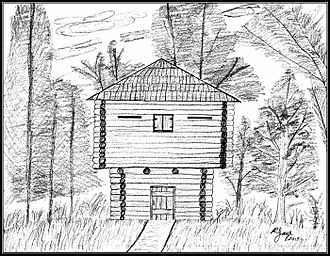Fort Fulton facts for kids
Quick facts for kids Fort Fulton |
|
|---|---|

Fort Fulton – a blockhouse style fortification used by militia volunteers and U.S. Army troops during the Second Seminole War - (artist's depiction).
|
|
| General information | |
| Type | Second Seminole War Fort |
| Architectural style | Log Blockhouse Fortification |
| Location | Palm Coast, Florida |
| Address | 7900 Old Kings Road N., Palm Coast, Florida |
| Coordinates | 29°40′28.03″N 81°15′15.25″W / 29.6744528°N 81.2542361°W |
| Completed | 1840 |
| Demolished | 1842 |
Fort Fulton was a small military post built in Florida. It was set up on February 21, 1840. The fort was located near Old Kings Road and Pellicer Creek. This area is now part of Flagler County, Florida.
Fort Fulton was important during the Second Seminole War. This war was fought between the United States and the Seminole people. The fort likely had volunteer soldiers called militia. These soldiers helped protect the area. It was close to Hewitt's Mill, a sawmill built in 1768. The mill supplied wood for buildings in St. Augustine.
Contents
Why Was Fort Fulton Built?
In 1840, the U.S. government decided to change its military strategy. Joel Roberts Poinsett, who was the United States Secretary of War, sent a letter. He suggested closing two older forts near St. Augustine. These forts were Fort Hanson and Fort Peyton.
The plan was to build three new forts instead. However, only Fort Fulton seems to have been built. It was actually finished before Poinsett's letter. Fort Hanson was abandoned in 1840 and later burned. Fort Peyton was also abandoned and burned in 1842. Fort Fulton helped replace these older posts.
What Did Fort Fulton Do?
Fort Fulton served as a military outpost. It connected St. Augustine to large farms called plantations further south. The fort was probably used by both militia and U.S. Army troops.
Its main jobs were:
- Defense: Protecting important travel routes.
- Communication: Sending messages between military groups.
- Reconnaissance: Gathering information about the area.
A blockhouse like Fort Fulton made sense in this location. It helped protect Old Kings Road and Pellicer Creek. These were key transportation paths during the war. There are no records of any battles happening at Fort Fulton itself.
Discoveries at the Fort Site
In the 1970s and 1980s, some interesting discoveries were made. A teacher named Buddy Taylor and his students from Belle Terre Middle School explored the site. They found several old items.
These items included:
- Military buttons
- Musket shot (bullets for old guns)
- A brass butt plate from a firearm (part of a gun's handle)
These artifacts were shown at the school's museum for many years. It is not known where these historical items are today.
What Happened to Fort Fulton?
Fort Fulton was likely abandoned around 1842. This was near the end of the Second Seminole War. It was probably burned down, like many other forts at that time.
An old map from 1846 shows Fort Fulton. But it's unlikely the fort was still active or standing then. Today, the site where Fort Fulton once stood is covered by thick plants. The only sign of the fort is a clear patch of sand among the trees.

